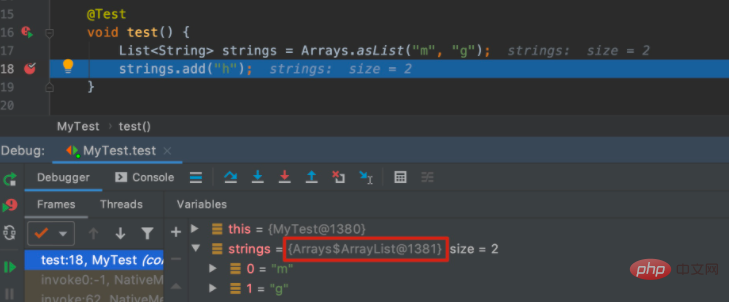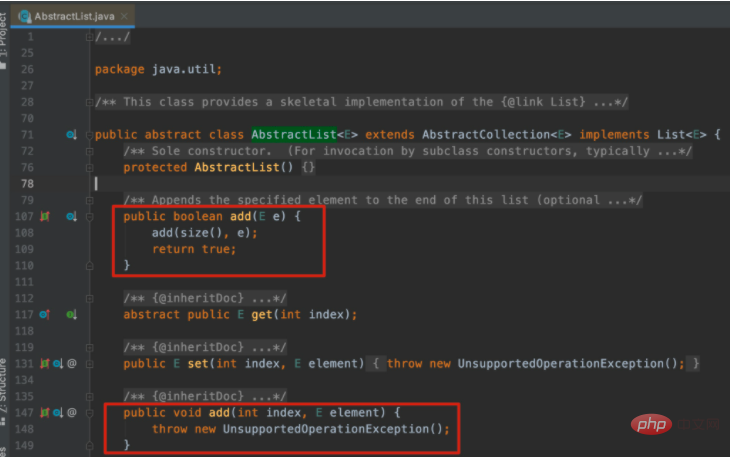Java basic tutorialColumn introduction Collection class includes two major categories: Map and Collection

Recommendation (free):java basic tutorial
Some high-level programming languages now provide the implementation of various out-of-the-box data structures, such as Java programming The collection framework of the language provides various implementations. The collection class includes two major categories: Map and Collection. The List below Collection is one of the collection classes we often use. Many business codes are inseparable from it. Today Let’s take a look at some pitfalls of List lists.
For example, if we execute the following code:
Liststrings = Arrays.asList("m", "g"); strings.add("h");
will throwjava .lang.UnsupportedOperationExceptionException, what is your OSat this time? Why can't elements be added to the returned ArrayList? Can elements be added properly in the future?, and then decisively enableDebugDafa:

found that the returnedArrayListis not our commonly usedjava .util.ArrayList, but the inner classjava.util.Arrays.ArrayListofArrays. Enter the methodArrays.asListand the source code is as follows:
public staticList asList(T... a) { return new ArrayList<>(a); }
The method returns the static internal classjava.util.Arrays.ArrayListofArrays, Although this class andjava.util.ArrayListalso inherit from the abstract classjava.util.AbstractList, but through the source code of this class, it is found that it does not have any reference to the abstract parent classAbstractList'saddmethod throwsjava.lang.UnsupportedOperationExceptionexception by default.

The root cause of this pitfall is that theaddmethod of thestringsreturned by our call is inherited from the abstract parent classaddmethod, and the method of the abstract parent class throws thejava.lang.UnsupportedOperationExceptionexception by default.
Arrays.asListmethod except the aboveDoes not support adding or deleting elementsIn addition to this pit, there is another pit:

It can be found from the above code that modifications to the original array will affect The newListwe obtained through theArrays.asListmethod can be found by digging into the source code ofjava.util.Arrays.ArrayList:
private static class ArrayListextends AbstractList implements RandomAccess, java.io.Serializable { private static final long serialVersionUID = -2764017481108945198L; private final E[] a; ArrayList(E[] array) { a = Objects.requireNonNull(array); } ... }
The original array is used directly, so we must pay special attention when we use theListobtained byArrays.asList. Because the array is shared, some unexpected bugs may occur when modifying each other. . One of the standard actions is to use it as a parameter of theArrayListconstructor method tonewaList(e.g.List) or passLists.newArrayListin theGuavalibrary, the newListwill be returned Decoupled from the original array, they will no longer affect each other.
When you directly traverse the collection elements, adding or deleting elements will report an error. For example, if you execute the following code:
ListstringList = Lists.newArrayList("m", "g", "h"); for (String s : stringList) { if (Arrays.asList("m", "h").contains(s)) { stringList.remove(s); } }
The above code can be compiled normally, but thejava.util.ConcurrentModificationExceptionexception will be thrown when executed. Looking at the source code, you can find that the deletion element methodremovewill modify the collection structure, and also That is,modCount (the number of actual modifications to thecollection) will be modified. During the loop, the actual number of modifications to the currentListcollectionmodCountwill be compared with the iterator modification. The number ofexpectedModCount, andexpectedModCountis themodCountduring initialization. If the two are not equal, aConcurrentModificationExceptionexception will be reported. There are two main solutions: 1. Use the iterator method ofArrayListto traverse, and then call the methods in it. 2. In JDK 1.8, you can use theremoveIfmethod to perform deletion operations.
Finally, a heart-wrenching question: Call theremovemethod ofArrayListand pass inintbasic type numbers andIntegerAre the execution results of packaging type numbers the same?
The above is the detailed content of Record the pitfalls of Java collection class List. For more information, please follow other related articles on the PHP Chinese website!